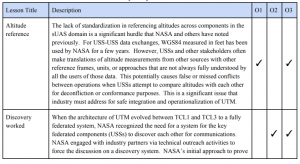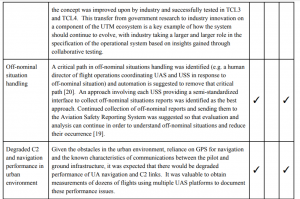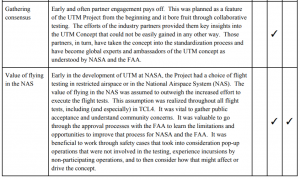A lack of standardization in referencing altitudes across components in the small unmanned aircraft system (sUAS) domain is a hurdle to implementing UTM systems in an urban environment but high-density operations can be managed in this environment and current UTM protocols can strategically deconflict 95% of operations, according to a report from NASA’s Unmanned Aircraft Systems (UAS) Traffic Management (UTM) Technical Capability Level 4 (TCL4) 2019 demonstrations and posted on Linkedin by NASA’s UTM Chief Project Engineer Joseph Rios.
According to one of the conclusions of the report:
“Results of the demonstration indicate the viability of the UTM concept to manage large scale operations and contingencies in an urban environment. The demonstration also provided insight into key technological gaps that must be addressed before such operations are routine, safe, and efficient.”
The primary research goals of TCL4 were to collect data to understand the requirements regarding safely enabling large-scale beyond visual-line-of-sight (BVLOS) sUAS operations in urban environments; evaluate the small UAS Detect and Avoid, Communications, Navigation, and Remote ID technologies available at the time of the demonstration; evaluate UTM services being developed to address technical and operational challenges of urban operations; and identify gaps in the capabilities of current technology which would be needed to enable urban operations, said the report.
Five scenarios (edited) were trialed:
- Scenario 1: In an urban environment, nominal high density UTM operations are taking place with multiple mission types and use cases being carried out.
- Scenario 2: A pop-up concert takes place at a local venue that results in a number of UTM operations in the area supporting a variety of use cases reaching medium to high density traffic levels.
- Scenario 3: UTM operations are being conducted in the vicinity of an active airport with a medium density of sUAS operations.
- Scenario 4: High density UTM operations are taking place in an urban environment.
- Scenario 5: Multiple events are taking place in a suburban area, which draws a gradually increasing number of sUAS performing a variety of supporting missions.
NASA applied several measures of performance (MOP) to these trials. Other conclusions from the trials were that latency is not a likely impediment to nominal operation of a future, operational UTM system, with the 95th percentile latency across all USS-USS messages being 532ms, and that of the 219 landings used in this analysis, 117 (~53%) occurred within 3m of a planned landing location or within an identified polygon, such as a contingency landing polygon.
The demonstrations took place between May and August 2019. Two Federal Aviation Administration (FAA)-designated UAS test sites (Reno, Nevada and Corpus Christi, Texas) managed the range and UAS service suppliers taking part comprised Uber Elevate, AirMap, AiRXOS (GE Venture), ANRA, Avision Robotics] and six UAS operators: Uber Elevate, AviSight, Drone America, Switch, Utah State University and AiRXOS.
Lessons learnt




The FAA and other regulators will be able to leverage results to inform future rule-making and identify additional gaps that require further analysis while standards organisations can begin work on developing key standards.
For more information
https://utm.arc.nasa.gov/docs/2020-Rios-Aviation2020-TCL4.pdf
(Image: Reno, Nevada, Shutterstock)




